Equities turned south again, with all major global indices under our radar trading in the red yesterday and today in Asia. This may have been due to reports saying that Russia hit a nuclear power plant in Ukraine. As for today, investors may pay attention to the US employment report for February, with a strong report having the potential to revive expectations over aggressive tightening by the Fed, especially with commodity prices surging, risking further acceleration in global inflation.
Equities, the Euro and the Pound Slide as Russia Hits Ukrainian Nuclear Plant
The US dollar traded mixed against the other major currencies on Thursday and during the Asian session Friday. It rebounded against EUR, GBP and CAD, while it lost ground versus JPY, CHF, AUD, and NZD.
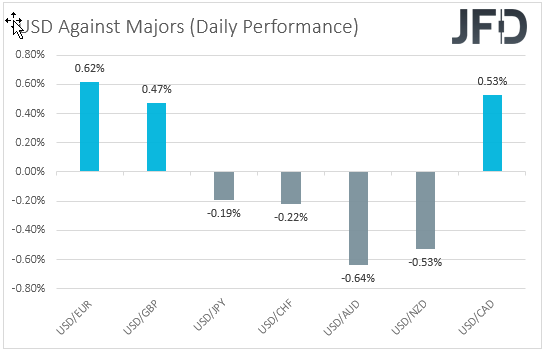
Although the simultaneous strengthening of the safe havens and the risk-linked currencies initially suggests a blurry outlook with regards to the broader market sentiment, for us, it’s clear that the ongoing crisis in Ukraine is once again the main market driver.
Safe havens receive support due to uncertainty, while, as commodity-linked currencies, the Aussie and Kiwi rallied as well, due to surging energy and other commodity prices. But why was the Loonie found lower this morning?
Perhaps there was some short-covering after Wednesday’s rally on a relatively upbeat BoC and surging oil prices. The slide in the euro and the pound add more credence to the view that the geopolitical tensions continue to weigh on the broader market sentiment.
Indeed, turning our gaze to the equity world, we see that major EU and US indices were a sea of red, with the negative appetite rolling into the Asian session today.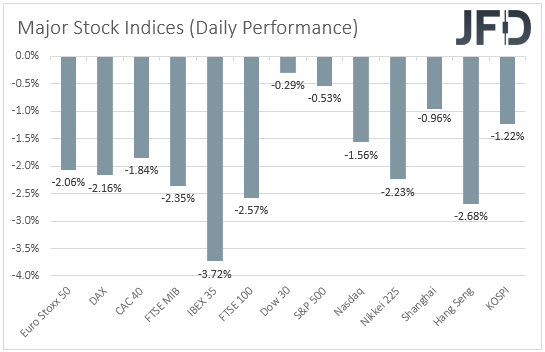
Investors took fresh fright yesterday, following reports that Russia hit a nuclear power plant in Ukraine, the largest of its kind in Europe. While subsequent reports said that there was no immediate change in radiation levels in the area, investors remained concerned that the whole situation could become even more dangerous, even after the two sides agreed to set up humanitarian corridors and a possible ceasefire around them for fleeing civilians.
As for our view, it has not changed. We stick to our guns and we repeat for the umpteenth time that it is too early to assume that the worst is over. Even following the aforementioned agreement, Russian forces continued surrounding and bombarding Ukrainian cities, with the conflict entering its second week.
Thus, we still believe that the path of least resistance for equities, the euro, and the pound, is to the downside. Oil and other commodity prices are likely to continue trending north, alongside the commodity-linked currencies. The US dollar and the other safe havens, yen, and franc, are likely to stay supported.
EUR/JPY – Technical Outlook
EUR/JPY traded lower yesterday, breaking below the 127.37 barrier, marked by the lows of Mar. 1 and 2, that way confirming a forthcoming lower low. The pair has been printing lower highs and lower lows since February 10th, as marked by a downside resistance line, and thus, we will consider the short-term picture to be negative.
We believe that the break below 127.37 may have opened the path towards the 126.40 zone, marked by the low of February 9th, 2021, or the 126.10 barrier, defined as a support by the low of February 4th, 2021. If the bears are not willing to stop at neither territory, then we could see them pushing towards the low of January 27th, 2021, at 125.60.
In order to start examining the case of a bullish reversal, we would like to see a clear and decisive break above the 128.75 barrier, marked by the high of March 2nd. This will confirm a forthcoming higher high on the 4-hour chart and signal the break above the aforementioned downside line. The bulls could then get encouraged to climb towards the peak of February 28th, at 129.73, the break of which could carry extensions towards the high of February 25th, at 130.28.
If they don’t stop there either, then we could see them challenging the 130.75 zone, marked by the peak of Feb. 22.
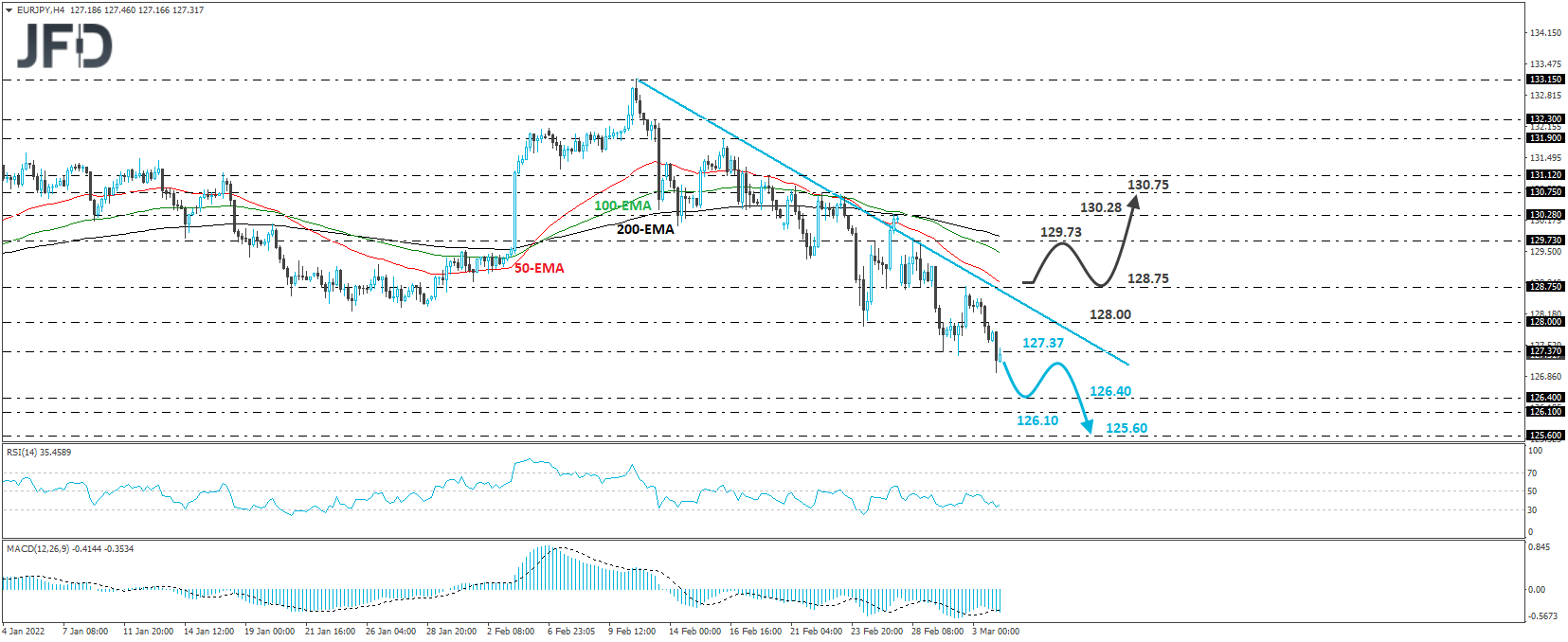
Will the US Jobs Data Revive Expectations Over Aggressive Fed Tightening?
As for today, investors may also pay some attention to the US employment report for February, which could help them form a better opinion on how fast the Fed may proceed with its tightening cycle. Nonfarm payrolls are forecast to have slowed, to 400k from 467k in January, but the unemployment rate is expected to have ticked down to 3.9% from 4.0%.
Average hourly earnings are expected to have accelerated somewhat to +5.8% YoY from 5.7%, which adds to the case of further acceleration in inflation in the months to come.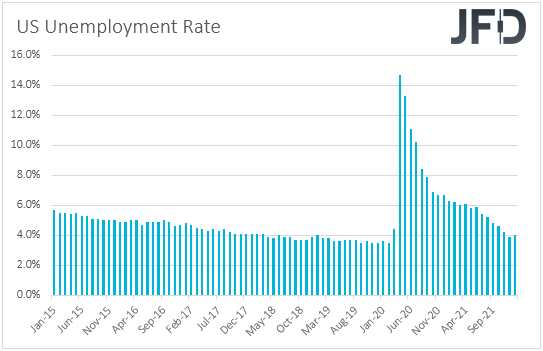
In our view, despite a slowdown in NFPs, the slide in the unemployment rate and the acceleration in wages are likely to keep expectations over a March hike and multiple more thereafter, elevated. After all, when testifying before Congress, Fed Chair Powell clearly said that he will support a quarter-point hike at the upcoming gathering, adding that he is ready to use larger or more frequent rate hikes if inflation does not slow.
A decent employment report is likely to keep the US dollar supported, while it may add extra pressure to equities. Monetary policy is the reason why we see equities keep drifting south, even when the crisis in Ukraine ends.
Yes, we are very likely to experience a relief bounce in such case, but expectations over aggressive tightening mean higher borrowing costs for companies sooner, as well as lower present values, especially for high-growth firms, which are valued based on discounted expected cash flows for the months and years ahead.
GBP/USD – Technical Outlook
GBP/USD traded lower yesterday, after hitting resistance slightly below the 1.3433 zone. On February 24th, the pair broke below the lower end of the sideways range that was in place since February 1st, but since the 24th, it’s been trading in a new trendless mode, between 1.3270 and 1.3440. That said, in the bigger picture, the pair remains below the downside resistance line taken from the high of July 29th, and thus, we see more chances for a downside exit out of the range rather than an upside one.
This could confirm a forthcoming lower low and may initially pave the way towards the 1.3200 barrier, marked by the low of December 21st, or the 1.3170 territory, which acted as a floor between December 8th and 20th. If the bears do not stop there, then we could see them aiming for the 1.3110 area, defined as a support by the lows of Nov. 12 and 13.
On the upside, a break back above 1.3490 would take Cable back within the prior, higher range, which was in play between Feb. 1 and 24. This could allow some more advances within that range, initially towards the 1.3540 hurdle, marked by the inside swing low of February 22nd, and then towards the 1.3620 or 1.3640 zones, marked by the highs of Feb. 23 and 21, respectively.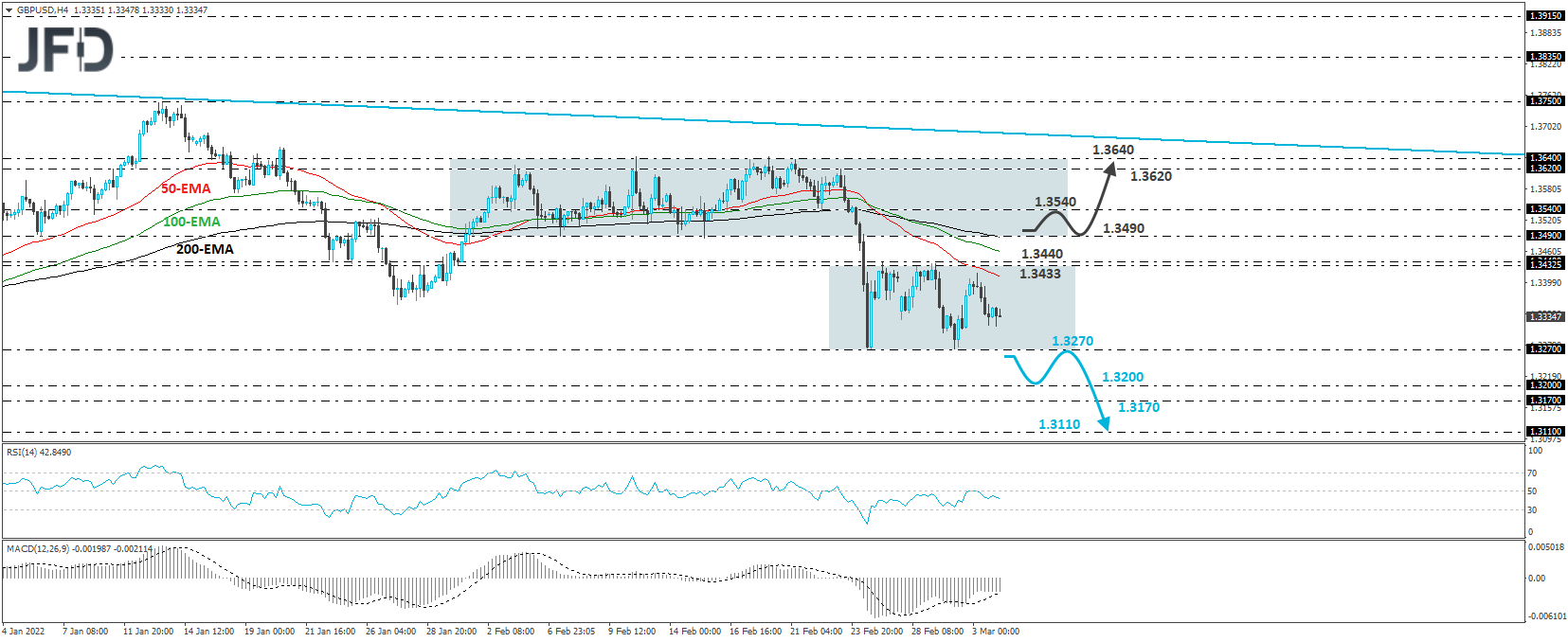
Elsewhere
We get Eurozone’s retail sales for January and Canada’s Ivey PMI for February. Eurozone sales are expected to have rebounded 1.5% mom after tumbling 3.0%, while no forecast is available for Canada’s Ivey index.
